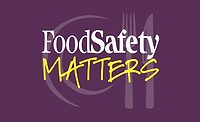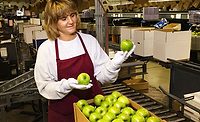Jack in the Box: Fostering Food Safety Through Great Partnering

Jack in the Box has tallied a lot of historic “firsts” in the foodservice industry. The company notes that in 1951, the same year that San Diego businessman Robert O. Peterson opened the first Jack in the Box location, Merriam-Webster first published the term “fast-food.” Jack in the Box holds the distinction of being the first quick service restaurant chain to develop and promote the concept of drive-thru dining. The company also introduced the industry's first breakfast sandwich in 1969 and the first portable salad in 1982.
In 1993, however, Jack in the Box experienced an industry first of another, less desirable kind: The restaurant chain associated with the earliest large-scale foodborne illness outbreak linked to the emerging pathogen E. coli O157:H7. Hundreds of people became ill and four people died from eating adulterated hamburger patties served at Jack in the Box restaurants in the Pacific Northwest. In the past 14 years, anyone who’s read the newspaper, viewed televised stories, attended food industry presentations, seminars and training, or scanned trade journals, books and websites that feature the topic of food safety knows that the 1993 outbreak is arguably the most cited foodborne illness event in industry history. And, even though the primary cause of the outbreak was traced to contaminated ground meat patties manufactured by one of the restaurant chain’s suppliers, it is Jack in the Box’s brand name that is synonymous with the nation’s first major E. coli O157:H7 wake-up call.
Normally this would be a bad thing. But despite being inexorably linked with such a high-profile foodborne illness outbreak for more than a decade of news features, slide shows and book chapters, today Jack in the Box is just as frequently cited as a food safety icon for its industry leadership in fostering proactive strategies and transparency throughout the supply chain. The company has received numerous accolades for its equally high-profile efforts in advocating higher industry food safety standards, including awards from the Food and Drug Branch of the California Department of Health Services in 2000, which recognized Jack in the Box’s assistance in drafting a 1997 state law requiring all restaurants to cook meat and eggs at specified temperatures to ensure safety. Jack in the Box’s comprehensive food safety and quality systems were also recognized in 2004 when the company was given the prestigious International Association for Food Protection Black Pearl Award, in recognition of the company’s efforts in advancing food safety and quality through consumer programs, employee relations and educational activities.
“When I arrived here in 1993 after the outbreak,” says David M. Theno, Ph.D., Senior Vice President, Quality and Logistics, “the people at Jack in the Box were personally devastated by what had happened. No one wants to be involved with making or selling food that harms people. I knew right then and there that our mission was clear: Food safety was priority one. Period. And as a company, we would need to not only apply that philosophy within our own operations and organization, but also promote this value to all of the suppliers we work with in order to truly accomplish that mission. And that’s what we did and what we continue to do.”
Making that vision a reality has been Theno’s passion for nearly 15 years, and his successful efforts have been recognized by government agencies, consumer advocacy groups and industry organizations. Most recently, he is the recipient of an NSF International 2007 Food Safety Award and a 2007 Food Safety Magazine Distinguished Service Award, which both recognize his innovative leadership in food safety education and advocacy. Under his direction, Jack in the Box’s food safety systems have become the gold standard against which other foodservice establishments benchmark the quality of their food protection management programs.
Theno and the company’s high-caliber, interdisciplinary team of food safety and quality assurance professionals are especially noted for openly sharing Jack in the Box’s programs with other companies, pioneering the concept that food safety is a noncompetitive issue.
“In our experience, we’ve found that if you really want to solve food safety problems to the extent possible,” says Theno, “you first need to know how you can improve safeguards in your own systems, and then you have to work together with all of the players in your supply chain toward a common goal. You cannot solve food safety problems individually. To make a significant change, food safety requires a holistic approach and you have to have partners dedicated to lining up their processes with yours.”
To significantly improve operational food safety in real-world practice, he adds, the industry requires a new kind of partnering approach that supports even greater transparency and sharing among companies than exists today. “Holistic solutions require coordinated holistic efforts. We are stronger as co-partners in ensuring food safety than we are as separate entities, it’s easier to work with partners than with adversaries, and we will be more successful in all areas of our businesses as a result. And importantly, we will have maximum impact on reducing the risk factors associated with foodborne illness.”
As might be expected, Jack in the Box is already in full-speed sales mode, proactively communicating with industry the benefits of taking this next-level approach to supply chain partnering.
Setting the Stage
Jack in the Box Inc. is one of the largest hamburger chains in the U.S., operating and franchising more than 2,050 quick service restaurants in 17 states. The company also operates and franchises through a wholly owned subsidiary Qdoba Mexican Grill restaurants, with more than 270 restaurants in 42 states. In total, Jack in the Box employs nearly 45,000 people and its restaurants serve more than 500 million customers annually.
In such an large operation involving a varied and extensive vendor and commodities supply chain, notes Theno, coordination of food safety measures and practices within four key operations is the most effective way to achieve truly holistic partnerships.
“There are four main areas where an enhanced partnering approach leads to holistic food safety solutions—at the supply chain level, with our commodities and technology vendors; at the restaurants, with employees; with the regulatory community; and at the corporate level, with our guests and distribution/ logistics suppliers,” Theno explains. “In 1993, these bases were compartmentalized, so although individual systems were adequate, they weren’t necessarily supporting overall food protection measures—which meant these systems did not address the gaps in food safety criteria and processes that existed at that time. We knew that we needed holistic solutions to close those gaps, and to do that we had to strengthen our interface with these different partners.”
Improved communication led to better coordination of food safety measures, adds Theno. “We could now simultaneously move forward in these four areas in terms of food safety protection improvements. That coordinated effort resulted in a comprehensive food safety system with a difference: Everyone involved in these areas would have access to and be expected to share food safety data and program information. Transparency became a key value.”
Jack in the Box’s success with this initial approach to solving the issues of 1993 is the foundation of its current food safety management strategy, Theno continues, but importantly, it has inspired a loftier idea: If every company throughout the entire supply chain fully commits to and expects a high level of food safety systems transparency within their vendor, regulatory, food handling facilities and corporate partner areas, the greater the probability that the highest level of food protection can be realized.
Supply Chain Partners
Partnering with commodities vendors to achieve holistic solutions can only be achieved through effective communication. One of the best examples of active partnering, explains Darren Blass, Jack in the Box’s Director of Quality Assurance and Product Safety, is the company’s work to reestablish its relationships with ground beef suppliers.
“In 1993, suppliers were not seeking us out to supply us, particularly ground beef producers,” he says. “One of the important things that we did was to develop better relationships with our suppliers by really sitting down with them and telling them what we needed, what we wanted to accomplish and how we might get there. Our primary message to suppliers was: Safe food is important, it’s mandatory, you have to have food safety systems in place.”
Those discussions developed into a positive dialogue, as suppliers shared their systems performance data and provided feedback on how they improve their own systems to help Jack in the Box meet its food safety goals. The result, says Blass, was that “ it became more than just a customer-supplier relationship based on price points; it developed into a true partnership.”
“They shared with us. We shared with them. What developed along the way is a very good food safety handling system predicated on the use of Hazard Analysis and Critical Control Points (HACCP) and other continuous process improvement systems for both our restaurants and vendors that, while innovative at the time, has become an industry standard today,” he continues.
Another benefit of greater communication with suppliers is that Jack in the Box was able to accumulate large amounts of food safety related data that was subsequently shared with others in the food industry to help everyone improve their supply chain controls, notes Blass. As a result, the restaurant chain has the most aggressive ground beef microbiological surveillance program in the industry, involving strict sampling, 15-minute lot sampling and finished product testing.
For the supplier based program, which extends from commodities and processing to transportation and delivery at the restaurants’ back doors, coordination of food safety measures is directly the result of this shared information. Enhanced communication also aids in supplier identification and selection and promotes food safety technology integration.
“All suppliers to Jack in the Box must have HACCP, GMPs, testing and reporting systems in place,” he says. “We audit processing plants and distribution centers to ensure that everything from raw materials receipt and sampling to sanitation to storage practices meets our specifications. What really makes the system work is that we not only developed this program with valuable input from suppliers but we actively share with them any information we gather that will further improve their systems—and therefore, ours.”
Restaurant Based Partners
In 1993, Jack in the Box was the first company in the restaurant industry to implement a HACCP program in all of its establishments. The restaurant-level food safety system includes many best practice components, such as set requirements for quality assurance checks of incoming products, cooking and storage temperature specifications, and hourly handwashing and sanitizing programs. The facilities and processes are audited and systems verified as working on a routine basis, and restaurant employees are supplied with the necessary tools to meet food safety goals, such as calibrated thermometers and automated hand sanitizer dispensers.
To ensure that these best practices are effectively communicated, Jack in the Box has developed a state-of-the-art interactive training program for all store employees. The computer-based training features audio, video, animation and text materials that can be accessed by trainees on a touchscreen system located in every store for continuous training and refreshers. Certification to the nationally recognized ServSafe training program is required of shift leaders, restaurant and area managers and regional vice presidents, and Jack in the Box is especially supportive of all levels of employees, from line cooks to corporate management, who aspire to these and other food safety training opportunities.
While it is critical to the success of the food safety program, says Theno, good training alone does not partners make. “We have fantastic training systems in place but to get the level of ownership in food safety that we see at the restaurant level it means sharing more than the ‘how’s’ and the ‘what’s’—you’ve got to share the ‘why’s’.”
Blass agrees. “It’s the holistic approach. It’s not just the fact that new applicants get a video introduction to food safety minute one, recieve training that is highly accessible, or that restaurant employees find the systems easy to operate and safe food handling practices easy to follow so that food safety becomes the default position. It’s all of these things together. People know what they are doing, but more importantly, why they are doing it, and that fosters real ownership in the process.”
Regulatory Partners
Some food industry entities still view local health departments and state and federal regulators as potential adversaries rather than valued partners in achieving food safety goals, comments Theno. “It is imperative that industry understands that we have the same mission as the regulators: safe food. There are real benefits to a good relationship with the regulatory community but first you have to establish trust. To do that you have to be willing to share information about how you implement food safety measures and why. You have to overcome the fear that they want to shut you down if they find a problem.”
Companies also have to be willing to seek out more than just compliance guidance from regulatory agencies to build a strong partnership, adds Blass. “Lisa Wright and her staff here at Jack in the Box get out and get in front of local health agencies to tell them about our food safety programs—what we’re doing and why it works—which gives them a very good understanding of the program.
“If a restaurant associate identifies a potential hazard or a guest reports a suspected illness, for example, we want them to report it immediately so we can investigate and implement corrective action as soon as possible if the situation warrants. When we call the local health department, we are going to tell them what’s going on, ask them for their assistance and request that they come out and inspect that restaurant. It is in our best interest to get their take on the situation because as Dave says, we all have a common goal.”
“It goes back to this idea of the benefits of forging a new kind of partnering approach to food safety,” says Theno. “The more each player in food safety knows about the management systems and measures in place, the better coordinated the efforts and the greater the chance that you’ve eliminated any food safety criteria gaps.”
Corporate Partnering
The fourth aspect to creating a holistic partnering approach to enhanced food safety is the corporate programs, says Theno. “This is not as direct but just as important, and involves a lot of different parts such as identification, selection and bargaining with the vendors, working with outside labs, support for the restaurants, support for guests, and training and incentive programs. It is the substructure that underlines the corporation supporting food safety and its execution.”
A good example of holistic partnering in this area involves creating partners of the restaurant’s consumers, says Jean Erwin, Manager, Guest Relations and Quality Hotline. “At Jack in the Box, we all own food safety together, and we all own a piece of what we are presenting to our customers. Making our guests partners in that ownership involves sharing our food safety expertise with them and being responsive to their need for that information.”
For example, Erwin explains, if a guest calls the Jack in the Box Hotline with a concern that he or she has a foodborne illness after dining at Jack in the Box, the hotline operator asks a series of questions to find out more about the symptoms, diagnosis and what products were consumed at what location. The operator has the opportunity at this point to talk to the guest about Jack in the Box’s testing programs, food handling and cooking programs, and handwashing and restaurant sanitation programs.
“What we find,” notes Erwin, “is that guests really appreciate getting good information in a responsive way. We talk with them, not at them, to really get to the source of the issue, and that is what partnering is all about.”
Creating a Proof-Positive Food Safety Legacy
“At Jack in the Box, we know first-hand how devastating foodborne illness is, and that knowledge is what drives us to continue to take a leadership role in the industry to find opportunities to ensure food safety by reducing the risk factors for foodborne illness,” states Theno. So, although some in the industry may doubt whether holistic partnering along the entire food supply continuum is achievable on such a large and complex scale, he adds, Jack in the Box will continue to promote this ideal as an industry goal worth working toward.
“We are proof of concept. People said you can’t control E. coli. People said you can’t train teenagers or non-English speaking employees and expect them to understand food safety concepts, much less take ownership. They said you can’t change systems without creating other food safety gaps, and you can’t expect companies to share information, even if it is considered non-proprietary. We proved you could,” Theno says.
And given its track record for historic firsts, the odds are that Jack in the Box will supply proof positive that its concept of holistic partnering is the next big thing in food safety.
Julie Larson Bricher is editorial director of Food Safety Magazine.
Looking for a reprint of this article?
From high-res PDFs to custom plaques, order your copy today!









